
Fractures Page Menu: 1 2 3 4 5 6 7 8 9 10 11 12 Next>>
Fracture Treatment During the Golden Age of Piracy, Page 7
Maintaining the Bone's Position: Splints
"That it [a fractured member] cannot be kept steady by this Bandage; therefore we make use of Ferulæ or Splints, whereof I have made mention in my Lecture of Fractures in general, with the Judgments of the Ancients, who have been very industrious in contriving ways to make equal Compression, and leave a way for the dressing of these compound Fractures." (Richard Wiseman, Of Wounds, Severall Chirurgicall Treatises, p. 423)
Splints were a key part of treating fractures during the golden age of piracy because they kept the adjusted bone straight. All of the period surgeons who discuss fractures mention them as part of their cure.
Splint Properties
"A Chirurgeon ought also to be provided with Splints of several bignesses, some little, others big, according to the qualities of the members broken, which ought to be made of thin pieces of Wood, or of Scabbards". (Guiliem Fabritius Hildanus aka. William Fabry, Cista Militaris, Or, A Military Chest, Furnished Either for Sea or Land, p. 27)
As Fabry suggests, splints had different properties which depended on what they were being used to support. With that in mind, let's look at the composition, size, and number of splints being used during the golden age of piracy
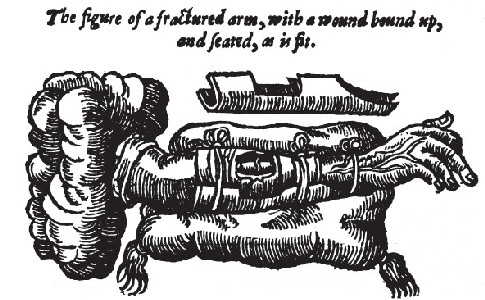
Detail of a metal or paste board splint, cut and fitted to the arm, from
The Workes
of That Famous
Chirurgeon Ambroise Parey,
by Ambroise Paré, p. 379 (1649)
Ambroise Paré explains that splints they were to be "composed of pastbord [pasteboard - thin firm boards made from sheets of paper pasted together - similar to the inside of a hardbound book cover], of thin splinters of wood, of leather,
such as shoo-soals [shoe soles] are made with, of the rinds [bark] of trees, of plates of latin, or lead, and such other like, which have a gentle and yeelding stiffness"1.
Richard Wiseman suggests that "If you think those [splints made] of Pastboard not strong enough, you may use Laminæ [thin sheets of], Copper or Tin-Plates lined with soft Linings, to receive the fractured Member, with Loops in the outside, to receive the three Ligatures [ties used to hold the plates in place] answerable to those which lie underneath next the Plaister, and they may be fastned and loosened at pleasure, without disturbing the Fracture, in the daily dressing of the Wound."2
Wiseman elsewhere suggests using scabbards sowed
inside linen as splints, although he warns that, "Scabbards are apt to bow, and so those of the thickest Pastboard, especially if they chance to be wet."3 Sea surgeon John Woodall suggests "at sea you may take for a shift two billets [short, thick pieces of wood] bumbasted [padded] with a little Ocum [Oakum] wrapt in and old peece of saile."4 Similarly, military surgeon William Clowes suggests that the splints be "made of light willow wood, being very plain and smooth and blunt and round at both the ends, well wrapped about and also bolstered with tow"5. Like
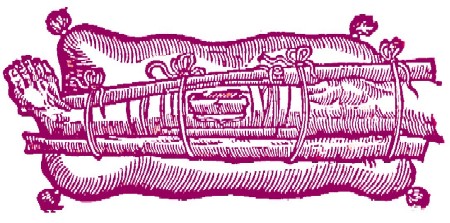
A Leg Fracture Showing the Size and Arrangement of Two Wooden Splints, from
The Workes
of That Famous
Chirurgeon Ambroise Parey,
by Ambroise Paré, p. 374 (1649)
Clowes, Hippocrates advises that wooden splints "be smooth, even, and rounded at the extremities"6.
A key to an effective splint was its weight, as Clowes' comment about using willow wood hints. Paré advises the surgeon to "have them made as light as may be, lest they by their weight become troublesome to the affected part."7 Wiseman explains that splints made "of Tin do very well, by reason of their lightness"8 while advising that "those of Wood are heavy, and apt to inflame the Member."9
With regard to the size of the splint, When treating arm fractures German military surgeon Matthias Gottfried Purmann advised two Fingers broad, and as long as they [need to be so that they] may reach a hands breadth above and below the Fracture"10. While dressing a thigh bone, Richard Wiseman used splints "of great strength and length, and of such compass [length] as may take in the lower half of the Member."11 With regard to splint length, sea surgeon John Woodall "the splints I appoint commonly [to be] so long as the member can beare without galling or troubling the next joynt"12.
Woodall
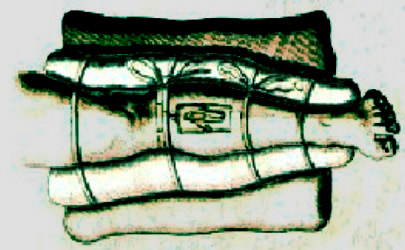
Juncts Shown on on a Compound Leg Fracture (Highlighted Bright White)
From Alle De
Medinale en Chirurgicale, by Solingen Cornelius (1698)
makes another interesting point about splints. For dressing a lower leg, he advises that the fractured part should "bee provided with the aforesaid bundles of reedes or bents [stiff stalks of grass], as thicke as the legge or thicker, to come from the foote, and one hand breadth over the knee, which should be wound and wrapped in canvasses and bound to each side of the legge"13.
Woodall further explains that bundles of reeds (which he calls 'junckes', meaning 'juncts') should come "downe to the floor, yea though onely the legge be fractured, it is fit these bundles of junckes bee as thicke and thicker then the member fractured, for that they may defend it in bed from wrong, and they are gently to bee bound to the member, that they may turne with it [the fractured part] if occasion be"14.
In a similar way, Richard Wiseman tells period surgeons not to use splints (referring to them as Ferulæ) while the fractured part is still swollen. Rather, during the early stages of healing, he suggests employing "Splenia, which are linen Cloaths folded four times double, and cut in length and breadth like the Ferulæ."15
German military surgeon Matthias Gottfried Purmann suggests paste board. As he explains, when "the Fracture is on the Arm [use] three or four [pieces of paste board], if on the Leg [use] four or five, two Fingers broad, and as long as they may reach a hands breadth above and below the Fracture"16.
Paré warns that "you must have a care, that they be smaller at their ends, and thicker in their middles whereas they lye upon the broken bone."17 This is similar to Hippocrates' suggestion that splint thickness be "somewhat less all along than the upper bandaging, and thickest at the part to which the fracture inclines."18
1 Ambroise Paré, The Apologie and Treatise of Ambroise Paré, p. 361; 2 Wiseman, p. 423; 3 Wiseman, p. 469; 4 William Clowes, Selected Writings of William Clowes, p. 128; 5 John Woodall, the surgions mate, p. 165; 6 Hippocrates, Hiipocratic Writings, Translated and Edited by Francis Adams, p. 72; 7 Paré, p.361; 8,9 Wiseman, p. 469; 10 Matthias Gottfried Purmann, Churgia Curiosa, p. 213; 11 Wiseman, p. 428; 12,13 Woodall,, p. 161; 14 Woodall,, p. 161-2; 15 Wiseman,p. 423; 16, Matthias Gottfried Purmann, Churgia Curiosa, p. 213; 17 Paré, p.361; 18 Hippocrates, p. 72-3
Splint Preparation
Applying a splint required care - it had to fit the part well without hurting the patient while keeping a fractured member in place. In preparation for using splints, period surgeons gave instructions on when they should be applied and how they should be formed to the fractured part.
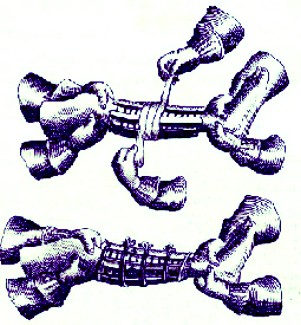
Splints Bandaged and Tied With Ligatures,
The
Chyrurgeons Storehouse, by Johannes Scultetus,
taken from Table 30 ,p. 106 (1653)
Hippocrates suggested adding splints to leg fractures between the seventh and eleventh days.1 As previously noted, he specifically advises against the use of splints in compound fractures while the wound is healing, advising that extra bandages be used instead.2
Richard Wiseman agrees, explaining that splints should not "be used till the Inflammation and Flux of Humours be off, which is not until the seventh day"3. He explains that regular splints could be applied once "Pain and Inflammation [have] gone off, and the Wound [is] digested, (if you think the Member not so subject to Inflammation, or that it requireth a greater strength to support it)"4.
Fitting the splints was an important part of preparing them. Ambroise Paré tells the surgeon to "let them [the splints] be fitted agreeable to the part whereto they must be used. Let also their figure be streight or crooked according to the condition of the member whereto they must be applied."5
Of course, Paré was writing about wooden splints. By the golden age of piracy, paste board splints were in use. Richard Wiseman recommends that the pasteboard pieces that made up the splints be cut so that they were "fit to receive the lower part of the Member, and leave a[n open] place commodious for dressing the Wound. Over the other part of the fractured Member you must place another piece of Pastboard to answer unto the former."6
When applying paste board splints, Wiseman recommends they the "be wet, [so] that they may lie more pliant."7 (We paste board could be formed around the limb.) German military surgeon Matthias Gottfried Purmann likewise suggests paste board splints be "first softned in hot Water"8. Wiseman goes on to explain, "The Pastboard as it dried, stiffened, and retained its shape, preserving the Fracture in the position I left it, and that with a very slack Bandage."9
1 Hippocrates, Of Fractures, Hippocratic Writings, Translated by Francis Adams, p. 77; 2 Hippocrates, p.85; 3,4 Richard Wiseman, Of Wounds, Severall Chirurgicall Treatises, p. 423; 5 Ambroise Paré, The Apologie and Treatise of Ambroise Paré, p.361;6,7 Richard Wiseman, Of Wounds, Severall Chirurgicall Treatises, p. 423; 8, Matthias Gottfried Purmann, Churgia Curiosa, p. 213; 9 Wiseman, p. 428; 1
Splints and the Comfort of the Patient
Of course, the way splints should be applied was a topic of much discussion for fracture treatment. Most of surgeons during the golden age of piracy who discussed splints advised protecting the patient from rubbing through the use of cloth splint covers and padding.
When describing the treatment of a fractured arm, Hippocrates recommended the surgeon "apply the bandages so as to suit the splints, and a little more tight than formerly, unless there be more pain from the swelling in the hand. When you have applied the bandages, you must adjust the splints all around the limb... without the application of the splints contributing at all to the compression of the arm."1 These bandages would supply padding to the limb.
In similar fashion, German military surgeon Matthias Gottfried Purmann recommended that paste board splints be "wrapt up in fine soft Linen Cloth, but leave the space of an Inch between each of them"2.
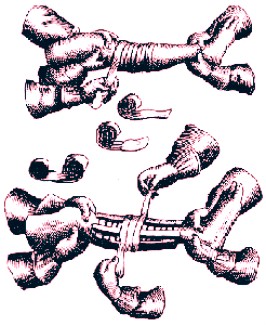
Bandages Padded the Wound Before Applying
Splints,
The
Chyrurgeons Storehouse, by Johannes
Scultetus,
taken from Table 30 ,p. 106 (1653)
John Woodall explains how he used a "great cloth to come over [the fractured limb] againe under the splints, which being close and smooth brought about the member, I then put [the cloth] under the first splint of a good bredth and length well armed with towe [pieces of loose, soft lint]."3 When bandaging a leg, Woodall suggests that this piece of cloth "bee longer then the splints, that the ends of the splints may rest thereon, and not on the bare legge, placing the splints in their order about the legge, till you have compassed the legge, laying them (as is said) not too close together, that they ride not one over the other, nor come upon the joynts"4.
When it comes to applying the splints, Hippocrates says, "Attention should be paid to the position of the splints about the ankles and along the tendon of the foot which runs up the leg."5 He continually advises concern for the comfort of the patient with regard to splints, suggesting that when spints are used, "if anything about the bandages annoys the patient, you should loose them [the splints] at the middle of the time, or a little earlier and apply them again."6
With similar concern for the patient's comfort, naval surgeon John Atkins gives an account of a fractured thigh where he covered "the Dressings with a Sheet of Pasteboard, (that came from above the Fracture to below the Calf,) placed the Leg and Thigh even, and in a Position easy to [the patient], kept the Great Toe in a Line with his Knee, and carefully filled up the Vacuities at the Ancle and Ham with Compresses"7.
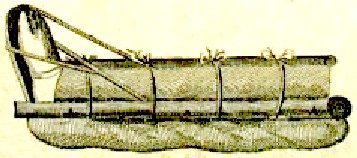
Protecting the Leg from Splints, from A General System of
Surgery
by Lorenz Heister, Plate 38 (1750)
Woodall explains that when splints create skin sores the surgeon should "apply next [to] the griefe for one dressing Ung. Triapharmacon [Unguent of Nutritum – made of litharge, olive oil and acetic acid] spred upon paper, and your other usuall medicine [for the fracture]"8.
1 Hippocrates, Of Fractures, Hippocratic Writings, Translated by Francis Adams, p. 85; 2 Matthias Gottfried Purmann, Churgia Curiosa,, p. 213; 3 John Woodall, the surgions mate, p. 161; 4 Woodall, p. 165; 5 Hippocrates,p. 82; 6 Hippocrates,p. 77; 7John Atkins, The Navy Surgeon, p. 59; 8 Woodall, p. 167; 9 Atkins, p. 44
Splint Attachment

Worsted Wool Tape
Attaching the splints to the fractured member was usually performed with fabric tape. You may recall that sea surgeon John Woodall preferred tape ties to roller bandages. Fabric tape is a flat worsted wool material (one, needless to say, without the adhesive on the back that we think of today when we hear the word 'tape').
When useing them, Woodall advises putting the tapes down first and setting the fractured limb on top of them before tying. As he explains in a case study, "under that [the fractured member] I lay foure or five strong tapes, then I tie one of the said tapes gently, and thrust all the rest of the splints under the same tape, namely, so many as may compasse [surround] the fractured member, lying close, but with some small distance, that they touch not one another, then I tie the rest of the tapes, drawing them close, till the party sensibly feele them to beare in all places."1 He later changes this advice slightly, explaining "in number it were fit to have five or six [tapes], namely, two on each end, and two for the middest"2.
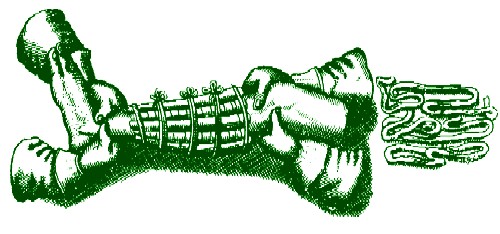
Splints Tied With Tape Ligatures With Tape Off To Side, From The Chyrurgeons Storehouse,
by Johannes Scultetus, taken from Table 30 ,p. 61 (1653)
Richard Wiseman suggests half as many ties, explaining that he attached splints in one case study how he fastened splints "by the three Ligatures [fabric ties] under [the fractured part and] made them fast, but without disturbance to the Patient."3
In similar fashion, German surgeon Matthias Purmann advised the surgeon to "bind [splints] twice round gently with a Fillet [fabric tape] an Inch broad"4. William Clowes and John Moyle also suggest using tape for fastening splints5, presenting unusually uniform advice from the various military and sea surgeon on this topic.
Hippocrates suggests that the surgeon "secure them [the splints] with strings so loose as just to keep them in their place"8. He recommended checking and tightening the ties holding the splints in place every couple of days, "always keeping in mind that the object of the splints is to maintain the lower bandages in their place, and that they are not needed in order to contribute to compression."6
1 John Woodall, the surgions mate, p. 161; 2 Woodall, p. 165; 3 Richard Wiseman, Of Wounds, Severall Chirurgicall Treatises,, p. 428; 4 Matthias Gottfried Purmann, Churgia Curiosa, p. 213; 5 See William Clowes, Selected Writings of William Clowes, p. 128 & John Moyle, The Sea Chirurgeon, p. 118; 6 Hippocrates ,p. 77
Splints on Fingers
In addition to normal limb splints, naval surgeon John Atkins talks about finger splints. As you might expect, the procedure is fairly similar to that of limb splints. Atkins explains that for digits, he uses
only a Plaister Compresses, and two Splints; Rowling I think inconvenient here, in that it wreaths the Finger aside, and makes a distorted Unition: The middle Part of the Plaster is to be applied on the Wound, and to come round the Finger, (first cutting out so much as may leave room for Dressing). The two small Splints with each a Compress, I place on the upper and under Part... and having tied the whole a couple of narrow Ligatures, place it to the Breast to be out of the way.1
1John Atkins, The Navy Surgeon, p. 53

